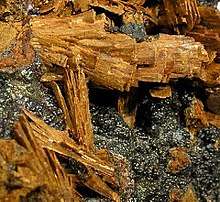Santabarbaraite
Santabarbaraite is an amorphous ferric hydroxy phosphate mineral hydrate that was discovered in Tuscany, Italy in 2000.[3] It also can be found in Victoria, Australia and Lake Baikal, Siberia.[4] This phosphate mineral has a simplified formula Fe3+3(PO4)2(OH)3·5H2O,[3] which is the same formula of another non-amorphous phosphate mineral called allanpringite.[5] Santabarbaraite occurs as pseudomorphic masses after vivianite (Fe2+3(PO4)2·8H2O). In the process, monoclinic vivianite oxidizes to form the amorphous santabarbaraite.[3] Pseudomorphism can be seen in Victoria, Australia in Wannon Falls which is originally a well-known locality for vivianite and at Lake Baikal, Siberia where the oxidized santabarbaraite can be seen as a rim surrounding vivianite due to exposure to air.[4]
| Santabarbaraite | |
|---|---|
 Santabarbaraite (pseudomorph) after vivianite | |
| General | |
| Category | Phosphate minerals |
| Formula (repeating unit) | Fe3+3(PO4)2(OH)3·5H2O |
| Strunz classification | 8.CE.80 |
| Crystal system | Amorphous |
| Identification | |
| Color | Brown/light brown |
| Crystal habit | Elongated or flattened prisms |
| Twinning | None |
| Cleavage | None, parting along {010} of replaced phase |
| Fracture | Conchoidal |
| Mohs scale hardness | Not determined |
| Luster | Vitreous/greasy |
| Streak | yellow-umber |
| Diaphaneity | Translucent |
| Specific gravity | 2.24 |
| Optical properties | isotropic |
| Refractive index | n = 1.659 |
| Other characteristics | Pseudomorphism |
| References | [1][2] |
Physical properties
Santabarbaraite samples, due to pseudomorphism, show elongated and flattened prism habits. The bulk crystal color is brown to light brown and but appears yellow brown when viewed in an optical microscope. The mineral's streak color is also yellow-umber.[3] Santabarbaraite has a vitreous to greasy luster and shows no fluorescence under ultra violet light. It is also translucent and shows good parting along the cleavage of its original mineral vivianite at {010}. Santabarbaraite's density is 2.24 g/cm3. The mineral is isotropic with refractive index n=1.659.[3]
The name
Santabarbaraite is named after the mining district Santa Barbara in Italy where it was found. The name also honors Saint Barbara, the saint of miners[3] which makes the mineral one of few named after women.
Geologic occurrence
Santabarbaraite occurs in several places. It occurs in the Valderno Superiore lignite-bearing basin in the Santa Barbara mining district, Tuscany, Italy.[3] Santabarbaraite samples can also be seen in Victoria, Australia underlying Pliocene basalt beneath Wannon Falls.[3] It is also found in samples from Lake Baikal, Siberia.[4]
References
- Santabarbaraite: Santabarbaraite mineral information and data
- Santabarbaraite Mineral Data
- Pratesi G., Cipriani C., Guili G., and Birch W. D. (2003) Santabarbaraite: a new amorphous phosphate mineral. European Journal of Mineralogy.15, 185-192
- Fagel N., Alleman L. Y., Granina L., Hatert F., Thamo-Bozso E., Cloots R. and Andre L. (2005) Vivianite formation and distribution in Lake Baikal sediments. Global and Planetary Change.46, 315-336
- Kolitsch U., Bernhardt H. J., Lengauer C. L., Blass G. and Tillmanns E. (2006) Allanpringite, Fe3(PO4)2(OH)3•5H2O, a new ferric iron phosphate from Germany, and its close relation to wavellite. European Journal of Mineralogy.18, 793-801